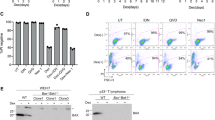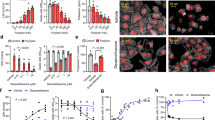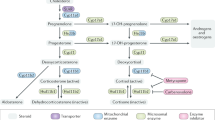Abstract
In near-physiological concentrations, glucocorticoid hormones cause the death of several types of normal and neoplastic lymphoid cell, but the mechanisms involved are unknown1,2. One of the earliest structural changes in the dying cell is widespread chromatin condensation, of the type characteristic of apoptosis, the mode of death frequently observed where cell deletion seems to be ‘programmed’3,4. It is shown here that this morphological change is closely associated with excision of nucleosome chains from nuclear chromatin, apparently through activation of an intracellular, but non-lysosomal, endonuclease.
This is a preview of subscription content, access via your institution
Access options
Subscribe to this journal
Receive 51 print issues and online access
$199.00 per year
only $3.90 per issue
Buy this article
- Purchase on SpringerLink
- Instant access to full article PDF
Prices may be subject to local taxes which are calculated during checkout
Similar content being viewed by others
References
Claman, H. N. New Engl. J. Med. 287, 388–397 (1972).
Thompson, E. B., Norman, M. R. & Lippman, M. E. Recent Prog. Horm. Res. 33, 571–615 (1977).
Kerr, J. F. R., Wyllie, A. H. & Currie, A. R. Br. J. Cancer 26, 239–257 (1972).
Wyllie, A. H. Differentiation (submitted).
Kerr, J. F. R. J. Path. Bact. 90, 419–435 (1965).
Kuo, M. T. & Hsu, T. C. Nature 271, 83–84 (1978).
Burgoyne, L. A., Waqar, M. A. & Atkinson, M. R. Biochem. biophys. Res. Commun. 39, 918–922 (1970).
Hewish, D. R. & Burgoyne, L. A. Biochem. biophys. Res. Commun. 52, 504–510 (1973).
Ishida, R., Akiyoshi, H. & Takahashi, T. Biochem. biophys. Res. Commun. 56, 703–710 (1974).
Finch, J. T. & Klug, A. Proc. natn. Acad. Sci. U.S.A. 73, 1897–1901 (1976).
Kaiser, N. & Edelman, I. S. Proc. natn. Acad. Sci. U.S.A. 74, 638–642 (1977).
Kaiser, N. & Edelman, I. S. Endocrinology 103, 936–942 (1978).
Bachvaroff, R. J., Ayvazian, J. H., Skupp, S. K. & Rapaport, F. T. Transplant Proc. 9, 807–810 (1977).
Williamson, R. J. molec. Biol. 51, 157–168 (1970).
Appleby, D. W. & Modak, S. P. Proc. natn. Acad. Sci. U.S.A. 74, 5579–5583 (1977).
Burton, K. Biochem. J. 62, 315–323 (1956).
Author information
Authors and Affiliations
Rights and permissions
About this article
Cite this article
Wyllie, A. Glucocorticoid-induced thymocyte apoptosis is associated with endogenous endonuclease activation. Nature 284, 555–556 (1980). https://doi.org/10.1038/284555a0
Received:
Accepted:
Issue Date:
DOI: https://doi.org/10.1038/284555a0



